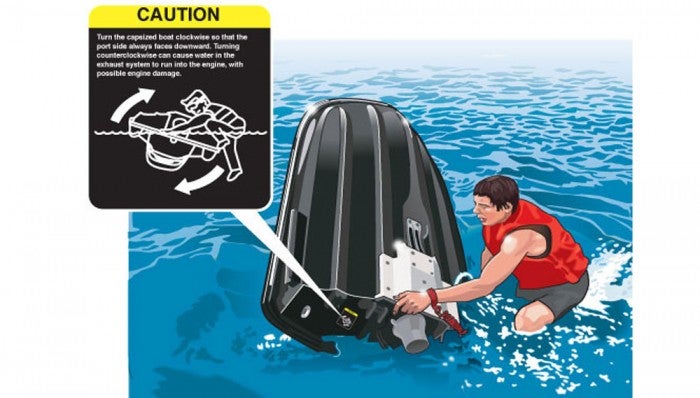How To Right a Capsized PWC

Act fast and smart to save your craft from engine damage
Own a personal watercraft long enough, drive it aggressively enough, or in some cases, just have a passenger that doesn’t shift their weight correctly in a turn, and you may experience the thrill of a PWC capsizing. And though in some instances the craft will roll right back up, in others it may stay upside down, forcing you to figure out how to get it back upright, and hoping that no engine damage is occurring in the process.
Here are several tips to avoid turning turtle, as well as how to right your craft properly should a flip occur.
First…Avoid Capsizing
Seems obvious, but one of the best ways to avoid the hassle of righting an overturned PWC is to keep it upright in the first place.
In reality, it’s pretty hard to flip one of today’s larger personal watercraft. They’re incredibly stable and built to handle a heavy passenger load. Flipping typically happens when riders are getting overly aggressive in a turn, trying to lose that third passenger in the saddle, or perhaps get caught mid-turn in an approaching wake.
 Modern personal watercraft are stable, but if your passengers don’t lean with you, it’s possible to capsize.
Modern personal watercraft are stable, but if your passengers don’t lean with you, it’s possible to capsize.To avoid flipping, think about your body weight. It should be kept to the inside of a turn. A common flipping scenario is when the driver makes a sharp, aggressive turn and the second, or more likely third passenger in the seat finds themselves flung to the outside. Their added weight, coupled with a tenacious grip on the passenger and driver in front, is a recipe for an almost unavoidable roll. Think about it – the driver is probably hanging onto the handlebars with all his might, trying not to go in. The pull of multiple passengers simply provides all the leverage necessary to send everyone into the drink.
Lesson? Anticipate turns, and lean into them as one unit, driver and passengers together.
Don’t Fight To Stay Aboard
Should you feel the inevitable roll starting to happen, and can’t recover, get clear of the craft. Too often riders hold on till that very last second, and get rolled under the water or bang a limb against the craft. If a roll is inevitable, just push off and get away from the boat. Especially if it’s fully loaded, there will be a tangle of passengers all getting unceremoniously dunked, so better to get clear and limit the possibility for bumps and bruises.
Check Your Crew, Stop the Engine
Once a PWC is completely upside down, make sure everyone aboard is safe, wearing their life jackets, and injury-free. Then, work to right the craft before any more time elapses. Why? The longer the boat is capsized, the greater the chance that water may be accumulating in the engine compartment.
Though a roll should have resulted in the driver pulling the safety lanyard and shutting off the engine, I’ve seen people roll and still stay tethered. If the engine is still running, pull the safety lanyard to stop it as quickly as possible.
Right the Boat…the Right Way
To right the craft, swim to the stern (rear) of the watercraft, and check for the manufacturer’s safety instructions. They’re typically adhered upside down, adjacent to the pump, for this very reason – so you can read them when flipped. Those instructions detail exactly which direction you should right the craft, a direction chosen so that any water inside the engine compartment, and the water inside the exhaust system, doesn’t get introduced into the engine and cause damage or difficulty restarting the craft.
|
|
Another way to think about it…the hull should be rotated so that the exhaust pipe always stays down, preventing water from flowing into the cylinders.
Typically, when facing the stern of the craft, this is a clockwise motion. Get the necessary leverage by pushing down on the portside rubrail with your foot and right hand, while grabbing the ride plate and pulling over with your left. An alternative method with exceptionally heavy craft is to put both feet onto the rubrail, and grab onto the intake/scoop grate bars and pull the watercraft back over. Just be careful with this latter method, as the ski is flipping toward you.
Start the Craft…and Drain Away Water
Once upright, re-board the craft, start the engine (with fingers crossed!), and then run the craft above planing speed in a relatively straight path for several minutes to drain away any water that has accumulated in the engine compartment.
Get PersonalWatercraft.com in your Inbox!
Like PersonalWatercraft.com on Facebook
Related Stories
Comments
Most Popular

2025 Yamaha JetBlaster PRO 2-Up Review

2024 Kawasaki Jet Ski STX 160X Review

Remembering the Sea-Doo XP

Whatever Happened to the Wetbike?

2025 Yamaha JetBlaster Review












 Your Privacy Choices
Your Privacy Choices